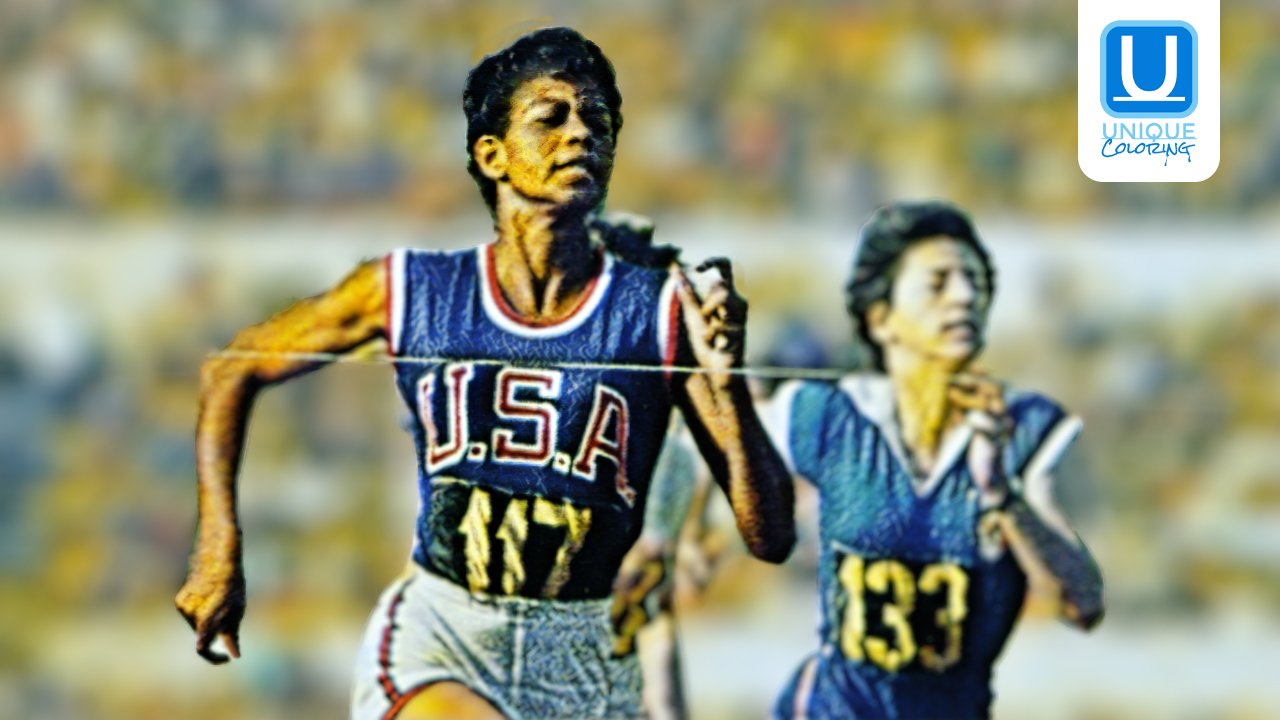Wilma Rudolph
The Fastest Woman in the World
Wilma Rudolph notching an Olympic win.
Wilma Rudolph became an international track and field athlete despite her childhood illnesses, including scarlet fever and pneumonia. Infantile paralysis, or polio, which she contracted at age five, left her with diminished strength in her left leg and foot. She was disabled for much of her childhood and wore a leg brace until age twelve. At one point, her doctor assured her she would never walk again, but Wilma’s fierce determination led to historic Olympic victories that caused the press to label her “the fastest woman in the world.”
Wilma Glodean Rudolph was born a premature baby, weighing 4.5 pounds, on June 23, 1940. She was born in Saint Bethlehem, Tennessee, a former unincorporated community in Montgomery County, now part of Clarksville. Her mother was Blanche Rudolph, and her father, Ed Rudolph, was a man twice married who fathered 22 children, of whom Wilma was number 20. Wilma’s family settled in Clarksville after she was born, and she received homeschooling until age seven due to the debilitating effects of polio. She started attending segregated schools in Clarkesville in 1947, beginning with Cobb Elementary. Her father took a job as a railway porter while working side gigs, and her mother was a housekeeper.
With so many siblings, Wilma received constant care and attention during childhood. Everyone took turns caring for her, with her siblings routinely removing her brace to massage her left leg. Even at so young an age, Wilma exhibited a relentless determination. She went from hopping around the house on one leg at age six to maneuvering more efficiently with the leg brace by age eight. And at age eleven, her mother found her playing basketball outside. Within a year, she stopped using her orthopedic shoe and leg brace. Wilma later attended Burt High School, where she joined the basketball team and played so well she became a starting player and was nominated an All-American. She also ran on the school’s track team during off-seasons.
“She joined the basketball team and played so well she became a starting player and was nominated an All-American.”
A black track and field coach from Tennessee State named Ed Temple noticed the star player during her sophomore year. Temple, who coached women, saw promise in Wilma and steered her toward a career in track and field. Wilma competed in her first major event as a high school track athlete at the Tuskegee Institute in Alabama. While she lost, she saw the sport as a new direction for her life and pursued it.
Coach Temple invited fourteen-year-old Wilma to join his summer training program at Tennessee State. What she learned at the training camp resulted in wins in nine events at an amateur track meet held in Philadelphia, Pennsylvania. Wilma became a member of the Tigerbelles, Tennessee State’s women’s track team. While still in high school, she competed in other amateur events at the collegiate level for two years. That culminated in Wilma traveling to Seattle, Washington, to attend track and field team trials for the 1956 U.S. Olympics. She qualified for the 200-meter individual race set for the summer in Melbourne, Australia. She was sixteen, making her the youngest member of the Tigerbelles five-woman squad.
While Wilma did not place in the 200-meter race during the Melbourne Olympics, she won the bronze medal with three TSU Tigerbelles. Isabelle Daniels, Margaret Matthews, and Mae Faggs ran along with Wilma in the 4 x 100-meter relay, and the four ladies tied the world-record running time of 44.9 seconds. Wilma returned to Tennessee exhilarated, and she set her sights on the 1960 Summer Olympic Games, set to be held in Rome, Italy, where she intended to win gold.
TSU Tigerbelles pictured from left to right: Wilma Rudolph, Lucinda Williams, Barbara Jones, and Martha Hudson at the 1960 Olympic Games held in Rome, Italy.
In 1958, she enrolled at Tennessee State and continued training under Coach Temple. She notched another win in 1959 at the Pan American Games. The Chicago event yielded a silver medal for Wilma in the 100-meter race and a gold medal for her and three teammates in the 4 x 100-meter relay. That same year, Wilma won the 100-meter title at the Association of American Universities (AAU) and was successfully defended her title for four years. She went on to win three indoor AAU titles as well.
After qualifying for the 1960 Summer Olympics, Wilma competed in three events. She placed first in each and won three gold medals for the 100- and 200-meter sprints and the 4 x 100-meter relay with teammates Lucinda Williams, Barbara Jones, and Martha Hudson. Wilma was the first black American woman to win three gold medals at a single Olympic Games. She even set a world record during the opening heat of the 200-meter dash. The significant wins led to the press labeling her “the fastest woman in the world.” Italian and French papers equated her with a gazelle and a locomotive, respectively.
Wilma Rudolph trains a young athlete in her post-athletic career.
Unlike previous Olympic Games, the 1960 Rome Olympics received worldwide television coverage. For that reason, several athletes won international acclaim. Riding the height of her Olympic success, Wilma toured Europe with her teammates and competed in various exhibition races. When she returned to Clarksville, Tennessee, the town welcomed her with festivities that included a banquet and a homecoming parade. Wilma had one request: full integration. Clarksville had never witnessed such an event, where thousands of blacks and whites celebrated an individual sans the racial divide.
Wilma Rudolph retired from track and field in 1962, at the height of her athletic career. Because she received no endorsement income from her Olympic victories, she became a teacher and coach, working with young athletes in various states. Wilma died at home in Nashville, Tennessee, on November 12, 1994. She was 54 years old. Wilma continues to inspire female athletes to this day.





Tamyra Mensah-Stock succeeded in defeating her opponent during the women’s 68-kilogram freestyle wrestling final at the Tokyo Olympics, making her the first black female in the U.S. to win gold.